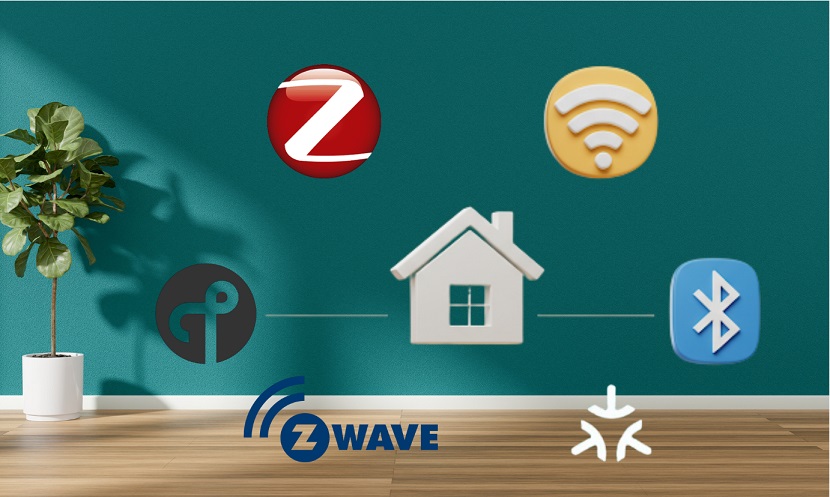Wi-Fi
Wi-Fi is a high-bandwidth wireless networking protocol ideal for streaming and internet-connected smart home devices. It offers wide coverage, high data transfer rates, and direct internet connectivity.
About eighty-five percent of homes today already have a Wi-Fi network, meaning interconnecting new smart devices does not usually need an additional hub or bridge. It's also very easy to connect these devices to cloud services.
- Frequency: 2.4 GHz and 5 GHz
- Range: Typically 30-50 meters indoors (depends on the router)
- Advantages: High speed, easy setup, no additional hub required
- Best for: Video doorbells, smart displays, streaming devices, web cameras
Bluetooth
Bluetooth is a short-range wireless communication protocol primarily used for personal device connectivity.
Bluetooth Low Energy (BLE) version enables energy-efficient communication for sensors and wearables. Limited network size and range make it less comprehensive for whole-home automation. Most useful for direct device-to-smartphone interactions.
Bluetooth devices can communicate with each other or with a smartphone or tablet without requiring a central hub.
- Frequency: 2.4 GHz
- Range: 10-30 meters (Bluetooth Low Energy)
- Advantages: Low power consumption, direct device pairing, widespread smartphone support
- Best for: Wearables, speakers, headphones, proximity sensors
Zigbee
Zigbee is a low-power, wireless communication protocol specifically designed for smart home and Internet of Things (IoT) devices.
It operates on the IEEE 802.15.4 standard, enabling low-data-rate, short-range communication with mesh networking capabilities.
Zigbee's key advantages for smart homes include its low energy consumption, which allows battery-powered devices to operate for years, and its ability to create robust, self-healing networks where devices can communicate through multiple pathways. Its standardized approach ensures interoperability between devices from different manufacturers, making it easier to build integrated smart home ecosystems.
- Frequency: 2.4 GHz
- Range: Up to 100 meters (line of sight), 10-30m indoors
- Advantages: Low power consumption, strong security encryption, mesh networking, interoperability
- Best for: Smart lights, sensors, thermostats, locks
Z-Wave
Backed by the Z-Wave Alliance, Z-Wave is a low-power, sub-GHz radio frequency protocol designed specifically for home automation.
It supports mesh networking with up to 232 devices, enabling extensive smart home ecosystems. It has lower interference than WiFi and is excellent for reliable communication between smart home devices.
It is a proprietary technology requiring Z-Wave certified devices, which limit manufacturer flexibility. Z-Wave operates on the ISM band in the 900MHz range, providing better wall penetration than 2.4GHz protocols.
- Frequency: 900 MHz (varies by region)
- Range: Up to 30 meters indoors, 100m outdoors
- Advantages: Low interference, strong security, mesh networking, superior wall penetration
- Best for: Light switches, door locks, thermostats, sensors
Matter
Matter is a new smart home protocol that was released in 2022 by the Connectivity Standards Alliance, previously known as the Zigbee Alliance.
Matter aims to create a universal and interoperable standard for smart home devices, regardless of the brand, platform, or technology. It's not a replacement for existing protocols but rather a unifying layer that works on top of them.
Backed by major tech companies like Apple, Google, Amazon, and Samsung, Matter aims to simplify smart home device integration and reduce consumer confusion about compatibility.
- Frequency: Supports multiple (Wi-Fi, Thread)
- Range: Varies by underlying protocol
- Advantages: Cross-platform compatibility, open-source, backed by major tech companies, simplified setup
- Best for: New smart home installations, bridging different ecosystems
Thread
Thread is a low-power, IPv6-based mesh network smart home protocol. Built on 6LoWPAN technology, it offers secure, reliable communication with minimal energy consumption.
It uses the same frequency band as Wi-Fi, but it creates a separate and dedicated low power network. Thread is based on the same 802.15.4 standard as Zigbee and like Zigbee, Thread is a mesh network.
By using Thread Border Routers, the devices have a degree of separation from the wider internet that might also help improve privacy and security while still maintaining IP connectivity.
- Frequency: 2.4 GHz
- Range: Up to 30 meters indoors
- Advantages: Low power, mesh networking, IPv6 support, self-healing
- Best for: Battery-powered devices, sensors, smart locks, thermostats




